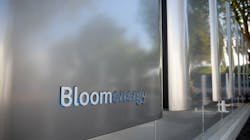Bloom Energy Rolls Out Commercial Hydrogen Fuel Cells
Bloom Energy last month reported the commercial availability of its Hydrogen Energy Servers – modular 100% hydrogen-powered fuel cells. The firm pointed out that it is taking orders for the fuel cells, suitable for microgrid applications, and expects commercial shipments to start next year.
“Bloom Energy has a complementary suite of solutions and strong partner ecosystem supporting both ends of the hydrogen economy – clean hydrogen production and efficient hydrogen utilization,” commented Deia Bayoumi, Bloom’s product management vice president. “With these offerings and collaborative solutions, our technology can be applied for today’s needs and in the future as the hydrogen economy becomes more robust.”
Observing that renewable energy sources such as solar and wind are inherently intermittent and at times produce more energy and generate more electricity than transmission lines can carry, Bloom stated that curtailment is needed to balance generation with consumption. Pairing renewables with the Bloom Electrolyzer – a hydrogen generation technology unveiled earlier this year – can avoid curtailment by producing, compressing, and storing hydrogen during periods of excess renewable production, the company noted. It added that introducing hydrogen-powered fuel cells allows the stored hydrogen to be converted into 24/7, zero-carbon electricity that can be used when needed.
Bloom also stated that its technology enables islanded or remote communities with renewable resources to self-generate fuel for reliable electricity – bypassing the need to import fuel. The company noted its Bloom Energy Servers use natural gas, biogas, hydrogen, or a mix of these fuels. It pointed out such fuel flexibility enables an accelerated transition to the hydrogen economy, adding that its solid-oxide platform addresses both the realities of today’s energy infrastructure and aspirations for the future energy ecosystem. Furthermore, the firm noted that Bloom Energy Microgrids provide modular and redundant power – and a cleaner alternative to diesel generators.
“Our technology is distinctively suited to help hydrogen adopters thrive in the hydrogen economy,” remarked Venkat Venkatarama, Bloom’s executive vice president and chief technology officer. “Bloom Energy’s hydrogen-powered fuel cells are built on the company’s solid-oxide platform that has higher efficiencies compared to other fuel cell technologies, generating more electricity from less hydrogen, and provides reliable power helping organizations reach to meet their zero-carbon objectives.”
Bloom stated that its Hydrogen Energy Servers have successfully undergone testing in a pilot project with SK ecoplant in Ulsan, South Korea. The firm noted the hydrogen-powered fuel cells provided 24/7, zero-carbon electricity throughout operation at higher-than-expected efficiency levels.
Customers of Bloom Energy technology include Fortune 100 companies in industries such as manufacturing, data centers, healthcare, retail, higher education, and utilities.
About the Author
EnergyTech Staff
Rod Walton is senior editor for EnergyTech.com. He has spent 17 years covering the energy industry as a newspaper and trade journalist.
Walton formerly was energy writer and business editor at the Tulsa World. Later, he spent six years covering the electricity power sector for Pennwell and Clarion Events. He joined Endeavor and EnergyTech in November 2021.
He can be reached at [email protected].
EnergyTech is focused on the mission critical and large-scale energy users and their sustainability and resiliency goals. These include the commercial and industrial sectors, as well as the military, universities, data centers and microgrids.
Many large-scale energy users such as Fortune 500 companies, and mission-critical users such as military bases, universities, healthcare facilities, public safety and data centers, shifting their energy priorities to reach net-zero carbon goals within the coming decades. These include plans for renewable energy power purchase agreements, but also on-site resiliency projects such as microgrids, combined heat and power, rooftop solar, energy storage, digitalization and building efficiency upgrades.
